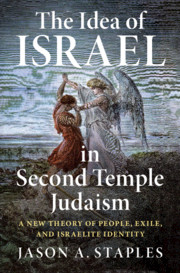Book contents
- The Idea of Israel in Second Temple Judaism
- The Idea of Israel in Second Temple Judaism
- Copyright page
- Dedication
- Contents
- Tables
- Preface
- Abbreviations
- Introduction
- Part I Israel’s Disputed Birthright
- Part II Restoration Eschatology and the Construction of Biblical Israel
- 3 Judah’s Bible and the Narrative Construction of Biblical Israel
- 4 Between Disaster and Restoration
- 5 The Restoration of Israel in the Persian and Hellenistic Periods
- Part III Israel and Restoration Eschatology in the Diaspora
- Bibliography
- Index of Primary Sources
- General Index
3 - Judah’s Bible and the Narrative Construction of Biblical Israel
from Part II - Restoration Eschatology and the Construction of Biblical Israel
Published online by Cambridge University Press: 29 April 2021
- The Idea of Israel in Second Temple Judaism
- The Idea of Israel in Second Temple Judaism
- Copyright page
- Dedication
- Contents
- Tables
- Preface
- Abbreviations
- Introduction
- Part I Israel’s Disputed Birthright
- Part II Restoration Eschatology and the Construction of Biblical Israel
- 3 Judah’s Bible and the Narrative Construction of Biblical Israel
- 4 Between Disaster and Restoration
- 5 The Restoration of Israel in the Persian and Hellenistic Periods
- Part III Israel and Restoration Eschatology in the Diaspora
- Bibliography
- Index of Primary Sources
- General Index
Summary
Too little scholarly attention has been paid to the paradox that those from the southern kingdom of Judah wrote, collected, and edited a foundational narrative not of Judah but of Israel, the ethnonym more closely associated with the northern kingdom even within the biblical narratives. This chapter argues that, rather than staking their claim to be the sole heirs to the heritage of the covenant with YHWH, the Judahite biblical editors constructed a biblical narrative that emphasizes that Judah is only one portion of a larger Israel that is presently—from the perspective of the editors and their implied audience—incomplete and awaiting reunion and restoration. By constructing an Israel of the past and rhetorically situating the reader in exile, the editors of the Primary History (Genesis–2 Kings) and 1–2 Chronicles establish a perspective of restoration eschatology in which an idealized biblical Israel (of course under the leadership of Judah) does not presently exist, having lost its status due to covenantal disobedience and disunity, but remains a social and theological aspiration.
Keywords
- Type
- Chapter
- Information
- The Idea of Israel in Second Temple JudaismA New Theory of People, Exile, and Israelite Identity, pp. 87 - 120Publisher: Cambridge University PressPrint publication year: 2021

